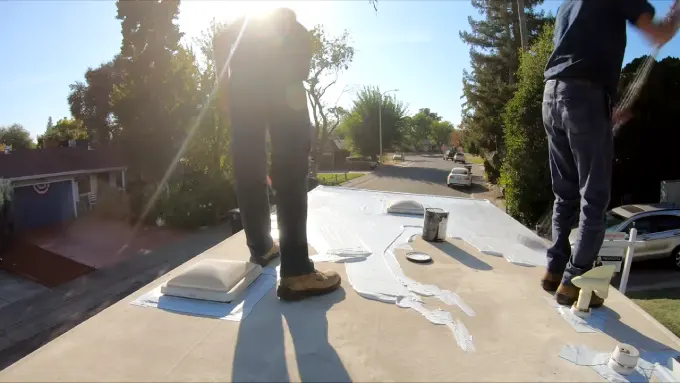Last Updated on March 25, 2023
Choosing whether to paint your RV roof white or reflective silver is an important decision that can affect the overall performance and longevity of your recreational vehicle.
Not only will it determine how much sunlight reflects off the roof and how comfortable you are inside, but it can also influence energy efficiency, waterproofing capabilities, and overall durability.
Let’s discover their respective benefits and explore their differences so that you can make an educated decision when selecting your perfect option.
Should I Paint My RV Roof White Or Reflective Silver?
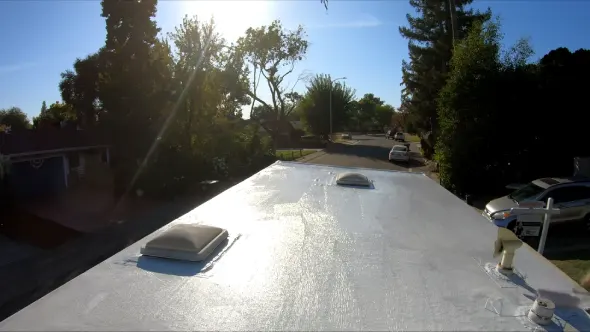
Advantages of a White RV Roof
A white RV roof is ideal for those looking to maximize their camping comfort and energy savings. It reflects sunshine, brightens the interior atmosphere, and requires less maintenance than other roofs that provide a relaxing environment you won’t want to leave! Learn more about why this upgrade could be perfect for your next road trip.
Reflects Sunlight and Reduces Heat Buildup
One of the most important benefits of a white RV roof is its ability to reflect sunlight, reducing heat buildup within the recreational vehicle. White surfaces have a higher albedo, which means they can effectively reflect a more significant amount of sunlight.
This reflective property helps keep the RV cooler’s interior, regardless of the outside temperature and can create a more comfortable environment for its occupants. Furthermore, a cooler interior requires less energy consumption by air conditioners, reducing the RV’s overall energy costs.
Provides a Brighter Interior
Another advantage of having a white RV roof is its ability to naturally brighten the interior spaces. With a lighter color palette, the sunlight entering the RV will bounce off the white surfaces, illuminating the rooms without the need for additional artificial lighting.
This creates a more pleasant living space and helps reduce the energy consumption required to power interior lights during the day.
Easier to Maintain and Clean
A white RV roof is easier to clean and maintain than darker shades. As dust, dirt, and debris tend to be more visible on a white surface, it allows for the timely identification of areas that require cleaning or maintenance.
Additionally, white surfaces generally do not absorb as much heat, making them less likely to suffer heat-related damage such as cracking, warping, or UV degradation, reducing repair and maintenance costs over time.
Advantages of a Reflective Silver RV Roof
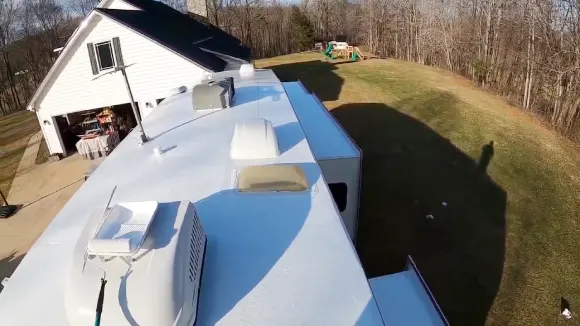
Owners of recreational vehicles can enjoy improved insulation, energy efficiency, and excellent durability with the simple application of a reflective silver roof.
This coating blocks harmful UV radiation and stands up better to wear and tear than other materials without extensive professional help. Here, we explain some of the benefits of reflective silver RV roofs.
Reflective Nature of Silver Coatings Reduces UV Radiation Penetration
One of the primary benefits of reflecting silver roofs is that they can deflect sunlight efficiently. This reduces the amount of ultraviolet (UV) radiation penetrating the RV’s roof, mitigating the harmful effects of UV exposure.
Furthermore, a silver roof can help decrease heat transfer into the RV by reflecting the sun’s rays, ensuring a relaxed and comfortable living space for its occupants.
Superior Insulation and Energy Efficiency
Reflective silver coatings have a higher thermal emissivity than their white counterparts, which means they can radiate more heat away from the RV. Consequently, the RV’s interior experiences increased insulation and enhanced energy efficiency, reducing energy costs for heating and cooling the vehicle.
Enhanced Durability and Resistance to Wear and Tear
Silver coatings contain metallic particles that provide an added layer of protection to the RV’s roof surface against damage caused by environmental factors, such as fluctuating temperatures, UV radiation, and weathering.
The metallic particles also contribute to the roof’s increased resilience against wear and tear, ensuring a longer lifespan.
Ease of Application
Applying a silver reflective coating to an RV roof can be a straightforward DIY project with the appropriate tools and materials. Numerous easy-to-follow instructional guides and videos enable RV owners to complete the task themselves.
This helps to save on professional installation costs, and the coating can be quickly applied and cured, reducing downtime for the RV.
Differences Between White RV Roof Coating and Reflective Silver
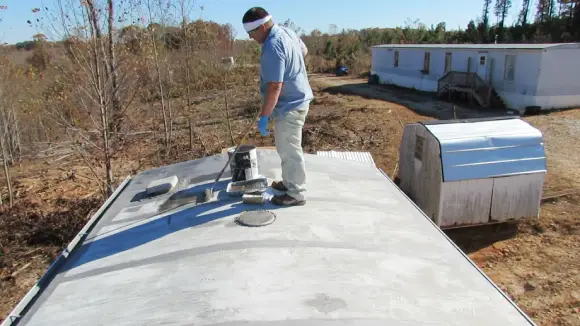
Regarding your RV’s roof coating, there are two principal options: white and reflective silver. Each has its own unique benefits, from durability and reflectivity levels for protection against the sun’s UV rays, cost-effectiveness in the coverage area, or environmental friendliness.
We offer a comprehensive breakdown of their differences here to help you decide which option best suits you and your situation.
1. Waterproofing
White RV roof coating is essential to maintaining your RV’s integrity by providing a waterproof barrier. This specialty elastomeric paint provides a seamless membrane that seals seams, fasteners, and other potential leak points.
As a result, it minimizes any water damage risks to your RV’s interior, prolonging the life and quality of your recreational vehicle.
The added benefit of a white RV roof coating is that it reduces the internal temperature of your RV. The high reflectivity of this type of coating bounces back the sun’s rays, decreasing the amount of heat that penetrates the roof.
Consequently, this helps in lowering energy consumption by reducing the need for extensive air conditioning use during hot summer months.
Reflective silver RV roof coating is another excellent option for waterproofing and temperature control purposes. This type of coating reduces the heat absorbed by your RV’s roof by reflecting sunlight effectively, similar to the white coating.
The silver coating’s reflective surface also aids in UV resistance, as it bounces back harmful ultraviolet rays, playing a vital role in RV roof maintenance and longevity.
2. Coating Durability/Frequency of Reapplication
Both white RV roofs and reflective silver coatings are popular for RV owners because of their durability and ability to withstand harsh weather conditions. However, the white coating usually offers more extended longevity between reapplications than its silver counterpart.
The flexibility of the white RV roof coating is a strong factor contributing to its durability. It allows the coating to expand and contract with the movement of the RV and varying temperatures, preventing cracks and damage.
The high-quality white coating can last several years without requiring reapplication, which translates to cost-efficiency for RV owners.
On the other hand, although the reflective silver coating also offers excellent durability, it may require more frequent reapplication compared to the white alternative.
Several factors can impact the longevity of these coatings, such as the quality of the product used and the climate conditions to which the RV is exposed. It is essential to take these factors into account when determining how frequently reapplication may be needed.
3. Sunlight Reflectivity Levels/UV Protection
White RV roof coatings are an effective and cost-efficient way to keep the interior of the RV cool while providing good UV protection. These coatings typically use an acrylic elastomeric or silicone blend and have a high reflectivity rate for sunlight. Reflective silver coatings also reflect light well but may not be as durable as a white coating due to their aluminum and reflective material blend.
Although these silver coatings provide excellent UV protection, they may not be as affordable as white coatings.
4. Afford to Apply
When deciding on an RV roof coating, it is important to consider affordability. White RV roof coatings may be more affordable than reflective silver coatings due to their durability and cost-efficiency. Factors such as size, complexity, and lifespan will also affect the overall cost of the application.
It is recommended to consult with a professional in RV maintenance or do research before determining which type of coating best suits your needs to ensure that you are making an informed decision about the most affordable option for your particular situation.
5. Coverage
White RV roof coating provides excellent coverage for an RV roof, as it is highly durable, UV-resistant, and versatile. It is also easier to apply than other coatings and can save time and money.
In comparison, the reflective silver coating is known for its highly reflective properties but may not provide the same level of coverage. Over time, this type of coating can become prone to cracking and peeling, leading to decreased performance.
6. Environmentally Friendly
White RV roof coatings are typically made from non-toxic and eco-friendly materials, meaning they are safe for use around the environment. Energy-efficient silver coatings offer better performance, but they may contain toxic materials that are difficult to dispose of.
This could have negative environmental impacts if not handled correctly. Therefore when choosing a coating for your RV roof, you should consider both the coverage benefits and environmental impact of each product to make an informed decision that meets your needs while minimizing any potential environmental damage.
Factors to Consider When Choosing Between White and Reflective Silver RV Roof Coatings
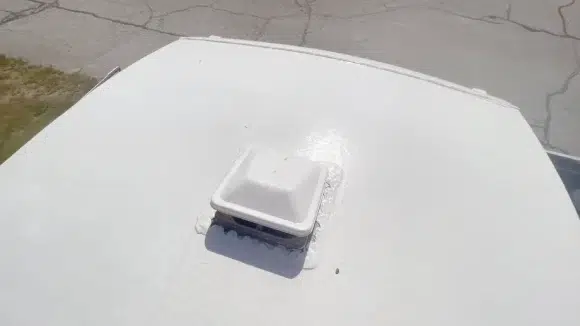
Choosing between reflective silver and white RV roof coatings is essential for RV owners. The two main factors to consider are personal preference, climate, and specific needs that might affect the choice.
Understanding the advantages and disadvantages of each type of coating can make it easier to decide which one will best suit your particular needs.
Personal Preference:
Personal preference can be a significant factor in the decision-making process when selecting a white or reflective silver RV roof coating. While some prefer the aesthetic look of white or light-colored coatings, others may enjoy the contrast and shine of reflective silver coatings.
White RV roof coatings are known for their clean look and easy maintenance; on the other hand, reflective silver RV roof coatings can offer a more modern and sleek appearance while reflecting sunlight away from the vehicle. Ultimately, it comes down to what you personally like best when deciding between these two options.
Climate:
Another factor to consider when picking a white or silver RV roof paint is climate. In hot climates, white roof coatings are often seen as beneficial because they absorb less heat than their darker counterparts; this helps lower temperatures inside your vehicle during hot days.
On the other hand, in colder climates where snowfall is more common, reflective silver roof coatings may be favorable. This is due to their ability to reflect warmth from the inside back out into the environment.
Ultimately, understanding how temperature affects each type of coating can help you select one best suited to your climate conditions.
Specific Needs:
In addition to considering personal preference or climate when selecting white or reflective silver RV roof coatings, specific needs may also affect your decision-making process.
For instance, if you’re looking for a coating that offers extra protection against UV rays or extreme temperatures, you’ll need to research which type offers more reliable protection before making a final selection.
If possible, speak with a professional who specializes in RV roofing materials so they can provide insight into which option best suits your specific needs based on their expertise in the field.
Having a basic understanding of the effects of temperature on each type of coating and researching any additional protection features each option has available can help make this decision easier.
This is especially true for those seeking an optimal solution for their RV’s exterior protection needs.
Is it better to have a darker or lighter roof on the RV?
The choice between darker and lighter roofs for an RV largely depends on the user’s climate and specific camping preferences. Generally, lighter colors reflect more sunlight and heat, while darker colors absorb more heat.
As such, a lighter roof is often recommended for hot climate/summer months, while a darker roof may be best suited for cool climate/winter months. It is essential to consider the type of roofing material and the design of the RV before making any final decisions.
Does painting the roof on the RV white reduce heat?
The paint on an RV roof can help reduce heat inside the vehicle since white surfaces reflect more sunlight and absorb less heat. A white surface reflects a greater percentage of the sun’s rays which helps keep the interior cooler in hot and sunny climates.
This can be particularly useful in avoiding uncomfortable temperatures inside the vehicle during the summer months.
How long does silver roof coating last on an RV?
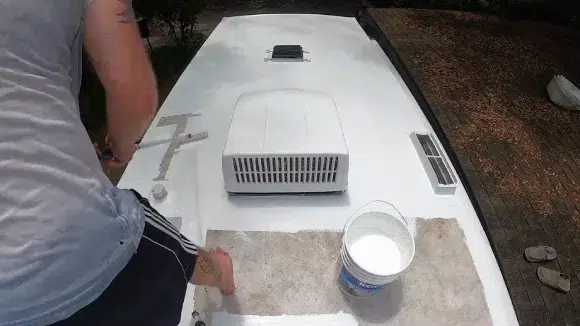
A silver roof coating on an RV typically lasts between 2 and 5 years. However, its lifespan can vary widely based on factors that include coating material, the prevailing weather conditions, and the frequency of use of the RV.
Harsh weather, such as extreme temperatures or heavy rainfall, can shorten the lifespan of the coating. To ensure that your silver roof coating lasts as long as possible, it is vital to perform regular inspections, maintenance, and roof cleaning.
Additionally, investing in a high-quality coating product and choosing a professional for the application process can help enhance the longevity of the coating.
How long does it take for a silver roof coating to dry on an RV?
The drying time of a silver roof coating on an RV depends on various factors, including temperature, humidity, and the thickness of the applied coat. Generally, the coating can take 4 to 24 hours to adhere and cure thoroughly.
You should follow the manufacturer’s instructions for your product to ensure optimal results. These instructions will guide you on the recommended drying time and ideal conditions for a proper cure.
It is essential to avoid disturbing the coating or exposing it to moisture during drying. This can negatively impact the performance and durability of the coating.
Choosing the Best RV Roof Coating
When deciding between a white or reflective silver RV roof, you should consider factors such as climate, personal preference, and specific needs to choose the best option.
Although a white roof may reflect more sunlight and reduce heat buildup inside the RV, a reflective silver coating may provide better insulation, enhanced durability, and superior UV protection.
Ultimately, by understanding the pros and cons of each type of roof coating, you can make an informed choice that ensures your RV stands up to wear and tear while providing maximum comfort for years.

